SMART-1 impact, September 2006 |

  |
SMART-1 impact, September 2006 |
 Sep 6 2006, 07:02 PM Sep 6 2006, 07:02 PM
Post
#106
|
|
|
Senior Member     Group: Members Posts: 1636 Joined: 9-May 05 From: Lima, Peru Member No.: 385 |
Doug and Remcook, Yes, that's clearly visible on both animations I'm surprised by the behavior of the cloud that seams to go sideway like blown by the wind. Do you feel the same? It might happen if, let suppose that one of the solar panels were broken away and it is hit on any rocky surface and the Moon dust is blown on the sides. However, the most dust must be ballistic. Rodolfo |
|
|
|
 Sep 6 2006, 07:05 PM Sep 6 2006, 07:05 PM
Post
#107
|
|
|
Senior Member     Group: Members Posts: 1636 Joined: 9-May 05 From: Lima, Peru Member No.: 385 |
Micrometeoritic impacts over the past several billion years. The surface of the moon is very very dusty. Doug But, not so dusty as the other places I have seen, as an example, the rural ways which lifts much dust than does the rovers on the moon. You can see the rovers going on the Moon and there is not so much dust as does in the Earth on dry ways. Rodolfo |
|
|
|
 Sep 6 2006, 07:53 PM Sep 6 2006, 07:53 PM
Post
#108
|
|
|
Founder     Group: Chairman Posts: 14432 Joined: 8-February 04 Member No.: 1 |
You can see the rovers going on the Moon and there is not so much dust as.... Wahahah? http://www.history.nasa.gov/alsj/a16/a16f.grandprix2.mov 7 -8 seconds in - LOTS of dust. The surface of the moon is almost ALL dust. Doug |
|
|
|
 Sep 6 2006, 08:08 PM Sep 6 2006, 08:08 PM
Post
#109
|
|
|
Member    Group: Members Posts: 147 Joined: 30-June 05 From: Bristol, UK Member No.: 423 |
Wahahah? http://www.history.nasa.gov/alsj/a16/a16f.grandprix2.mov 7 -8 seconds in - LOTS of dust. The surface of the moon is almost ALL dust. Doug I think that what is non-intuitive here is the fact that, on the moon, even the finest dust settles out as fast as a dropped weight, so dust doesn't hang around for long. Remember the rock vs. feather experiment. This gives the impression of not being as dusty as Mars. But if you were to inject a little atmosphere around the place, the sky would be thick with dust. So I can see what RNeuhaus is saying but, doug is right, the Moon IS VERY dusty it's just that it settles fast. Nick |
|
|
|
 Sep 6 2006, 08:46 PM Sep 6 2006, 08:46 PM
Post
#110
|
|
|
Senior Member     Group: Members Posts: 1636 Joined: 9-May 05 From: Lima, Peru Member No.: 385 |
I think that what is non-intuitive here is the fact that, on the moon, even the finest dust settles out as fast as a dropped weight, so dust doesn't hang around for long. Remember the rock vs. feather experiment. This gives the impression of not being as dusty as Mars. But if you were to inject a little atmosphere around the place, the sky would be thick with dust. So I can see what RNeuhaus is saying but, doug is right, the Moon IS VERY dusty it's just that it settles fast. Nick Thanks Nick and Doug for the good note and nice rover movie respectively in which I am a fan of off-road. Yes that I know that Moon is dusty but I was trying to measure about how dusty it is. After seen the rover movie, it is evident in spite of the fact that the rover went rather slow, the dust was lift on around the wheels that is not similar to a desert but a dry road or surface (previously was wet). I agree both of you but what I am saying is from the intuition. However, I recognize that it is difficult to evaluate more realistically it by seeing only from the movie with a rather poor resolution. So the case is closed with a beer in a pub! Rodolfo |
|
|
|
 Sep 6 2006, 11:50 PM Sep 6 2006, 11:50 PM
Post
#111
|
|
|
Junior Member   Group: Members Posts: 81 Joined: 19-April 05 Member No.: 256 |
is that a simple differencing of the images wrt the pre-impact image? Looks cool though! http://www.cfht.hawaii.edu/News/Smart1/#Dust That is some pretty amazing video. If I read the caption correctly, the frame size is 200km x 200km which makes the dust plume at least 50 - 75 km long. The frames were taken with an infrared camera, are we seeing the remnent heat from the impact or is the dust popping up into the sunlight? |
|
|
|
 Sep 7 2006, 12:14 AM Sep 7 2006, 12:14 AM
Post
#112
|
|
|
Solar System Cartographer     Group: Members Posts: 10153 Joined: 5-April 05 From: Canada Member No.: 227 |
One other thing to consider - you would only need a small amount of residual fuel to produce a cloud of vapor capable of lifting a bit of very fine dust, changing the 'ballistic dust' situation quite a bit.
Phil -------------------- ... because the Solar System ain't gonna map itself.
Also to be found posting similar content on https://mastodon.social/@PhilStooke Maps for download (free PD: https://upload.wikimedia.org/wikipedia/comm...Cartography.pdf NOTE: everything created by me which I post on UMSF is considered to be in the public domain (NOT CC, public domain) |
|
|
|
| Guest_DonPMitchell_* |
 Sep 7 2006, 03:44 AM Sep 7 2006, 03:44 AM
Post
#113
|
|
Guests |
There were claims made to have seen the Luna-2 impact on the Moon. That seems doubtful with the telescopes of that time, even though the craft (including the rocket 3rd stage) was bigger than SMART-1.
|
|
|
|
 Sep 7 2006, 12:43 PM Sep 7 2006, 12:43 PM
Post
#114
|
|
 Member    Group: Members Posts: 593 Joined: 20-April 05 Member No.: 279 |
That is some pretty amazing video. If I read the caption correctly, the frame size is 200km x 200km which makes the dust plume at least 50 - 75 km long. The frames were taken with an infrared camera, are we seeing the remnent heat from the impact or is the dust popping up into the sunlight? ...or is it the heating of the surface by falling debris? Whichever it is, given that the plume fades at 50-75km, and lasts for 130 seconds or so, that allows us to look at the ballistics for the most energetic (in terms of range) element of this visible debris. I see launch angles/ejection velocities ranging from: 24 deg @ 300 m/s, through to a peak around 12 deg @ 500, and fading out at 8 deg @ 700 m/s, to fulfill those criteria. Quite different to the impact angle of <1 deg and velocity ~2000 m/s. Does that give us any clue to the topography of the impact area? Andy |
|
|
|
 Sep 7 2006, 02:17 PM Sep 7 2006, 02:17 PM
Post
#115
|
|
|
Senior Member     Group: Members Posts: 2454 Joined: 8-July 05 From: NGC 5907 Member No.: 430 |
Dust cloud produced by Luna 5 impacting the lunar surface:
http://ntrs.nasa.gov/archive/nasa/casi.ntr..._1979073878.pdf -------------------- "After having some business dealings with men, I am occasionally chagrined,
and feel as if I had done some wrong, and it is hard to forget the ugly circumstance. I see that such intercourse long continued would make one thoroughly prosaic, hard, and coarse. But the longest intercourse with Nature, though in her rudest moods, does not thus harden and make coarse. A hard, sensible man whom we liken to a rock is indeed much harder than a rock. From hard, coarse, insensible men with whom I have no sympathy, I go to commune with the rocks, whose hearts are comparatively soft." - Henry David Thoreau, November 15, 1853 |
|
|
|
 Sep 7 2006, 03:47 PM Sep 7 2006, 03:47 PM
Post
#116
|
|
 Special Cookie     Group: Members Posts: 2168 Joined: 6-April 05 From: Sintra | Portugal Member No.: 228 |
-------------------- "Ride, boldly ride," The shade replied, "If you seek for Eldorado!"
Edgar Alan Poe |
|
|
|
 Sep 13 2006, 12:09 AM Sep 13 2006, 12:09 AM
Post
#117
|
|
 Senior Member     Group: Members Posts: 2492 Joined: 15-January 05 From: center Italy Member No.: 150 |
SMART-1 impact simulated in a laboratory sand-box
Laboratory simulations of the SMART-1 impact performed at the University of Kent, United Kingdom, suggest that the impact may have caused a clearly elongated lunar crater, and produced a high-speed rebounding for the spacecraft... -------------------- I always think before posting! - Marco -
|
|
|
|
 May 2 2013, 03:48 AM May 2 2013, 03:48 AM
Post
#118
|
|
 Newbie  Group: Members Posts: 6 Joined: 28-April 13 Member No.: 6918 |
Is this the SMART-1 impact crater?
SMART-1 location shown on ACT-REACT QUICKMAP 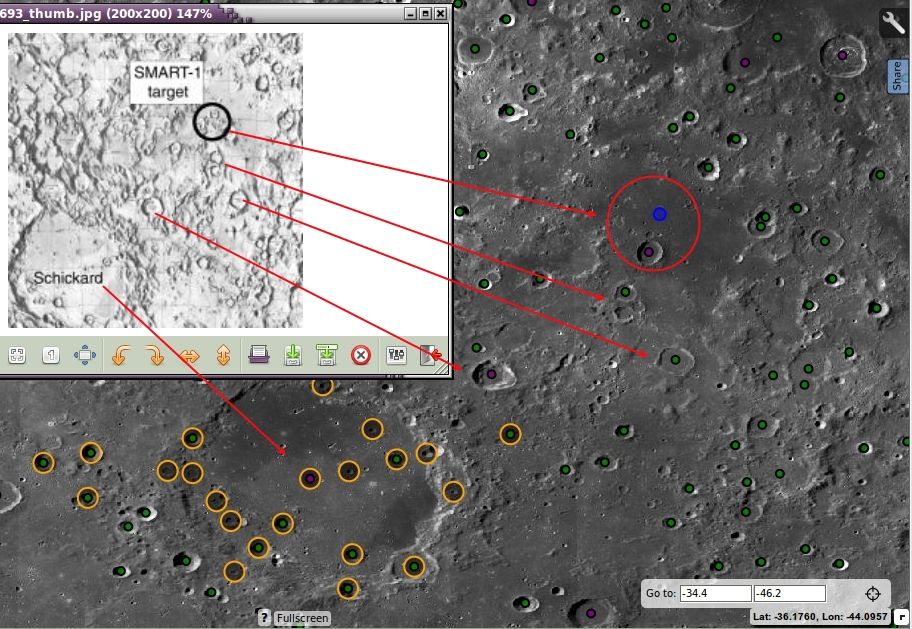 Another set of impact coordinates in the same area but NW of location can be found here which states "SMART-1 ended its journey in the Lake of Excellence, in the point situated at 34.4º South latitude and 46.2º West longitude."  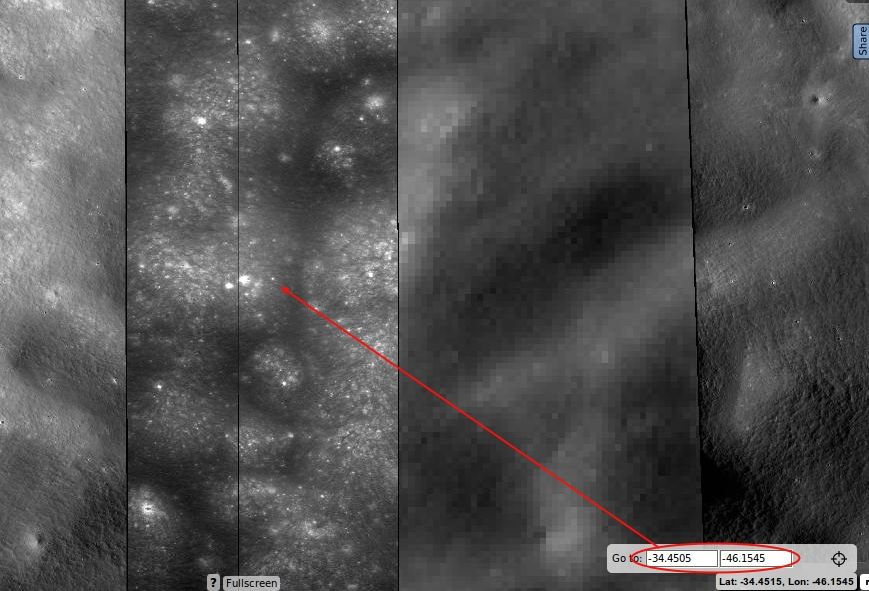 This site shows SMART-1 impact simulated in a laboratory sand-box This site shows Smart-1 nominal impact location and lists 46.2º West longitude and 33.3º South latitude as impact location This site here lists the impact point as 33°S and 46.2°W which is in Doppelmayer Y but nothing shows up at that exact location This site here lists coordinates as 36.44º south of latitude and 46.25º west of longitude, and doesn't appear to have an impact crater. This site lists multiple impact points for different orbits and lists other interesting information regarding viewing and impact crater creation This appears to be a good candidate and is located at -34.4502 lat -46.1559 lon 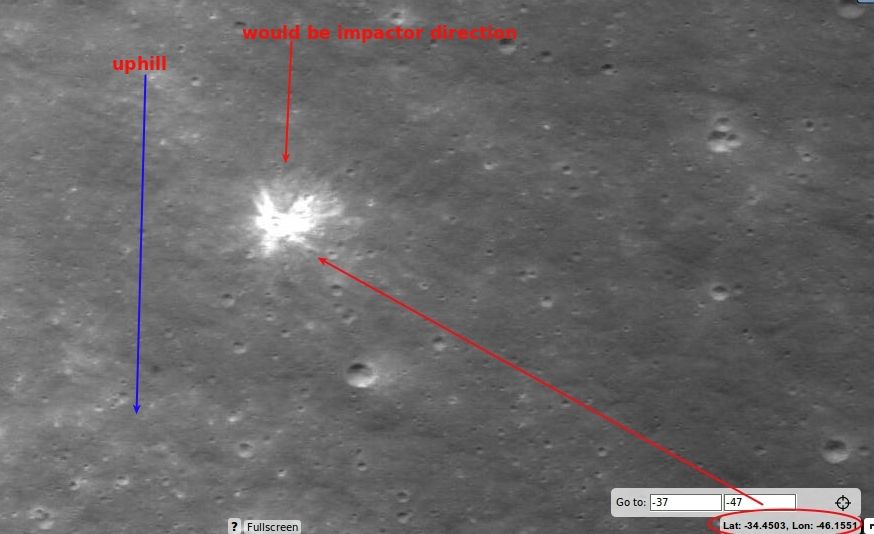 it is a butterfly impact and is on the side of a mountain 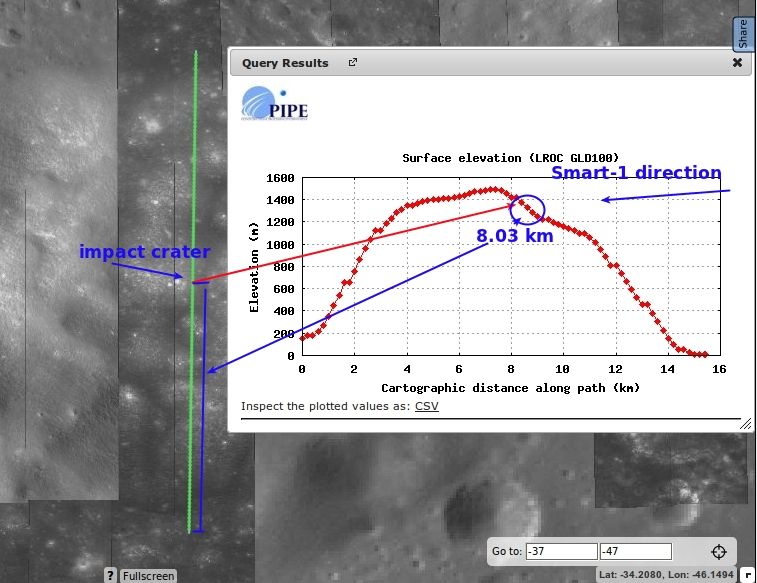 I put in a request @ LRO/LROC Target Observation Request for this area 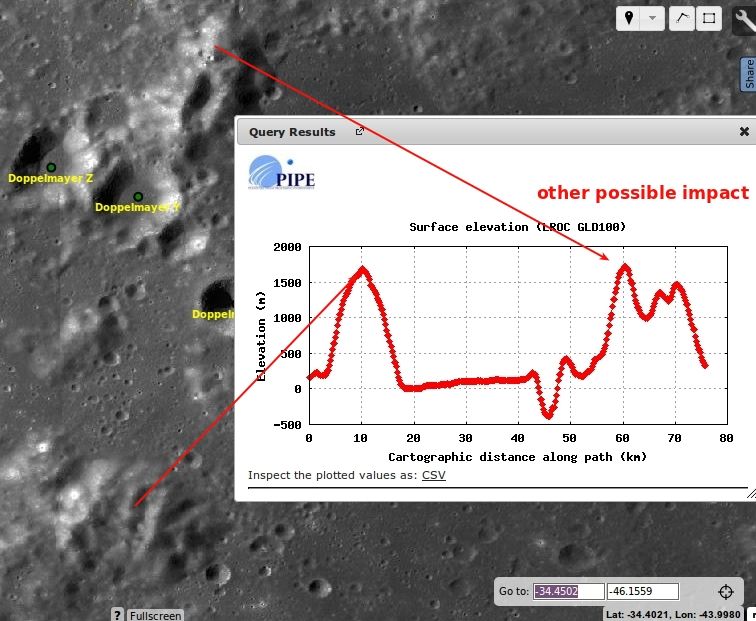 3D views of possible impact area 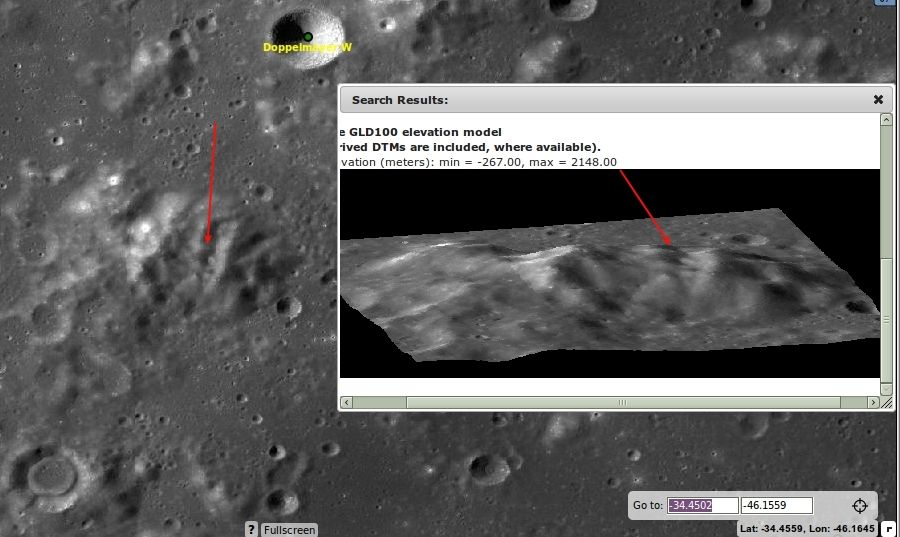 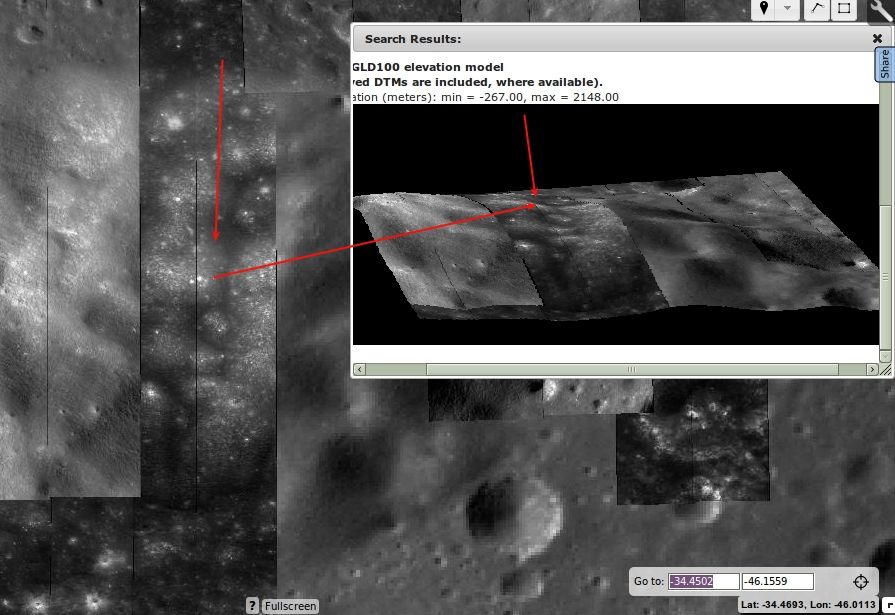
-------------------- "If you can't explain it simply, you don't understand it well enough"
- Albert Einstein |
|
|
|
 Jan 29 2017, 10:22 PM Jan 29 2017, 10:22 PM
Post
#119
|
||
|
Solar System Cartographer     Group: Members Posts: 10153 Joined: 5-April 05 From: Canada Member No.: 227 |
I have a new candidate for the SMART-1 impact crater as of about an hour ago!
First I will comment that one problem with the crater identified higher up on this page is that its ejecta deposit is spread around quite a bit of its rim rather than forming a fan extending downrange. We know a lot more about these very low oblique impacts now, from GRAIL, LADEE and my recent observations of Chang'E 1 and two Apollo LM ascent stages. The ejecta should be strongly focussed in the downrange direction. And so today I looked again, and found this: These are the only three images. There is an elongated gouge about 22 m long and 3 or 4 m wide. Two images, with morning and afternoon illumination, show the gouge clearly. The third, on the left, is the highest resolution image (0.5 m/pixel) and has local noon illumination - from the north at this southern latitude. It shows a fan of light rays extending south from the gouge (the spacecraft was passing from north to south) with hints of a few dark rays or gaps between bright rays. The size and form match simulations and lab experiments for the impact (see Burchell et al., Icarus, v. 207 (2010) pp. 28–38). The location is 34.262 S, 46.193 W (313.807 E) Phil -------------------- ... because the Solar System ain't gonna map itself.
Also to be found posting similar content on https://mastodon.social/@PhilStooke Maps for download (free PD: https://upload.wikimedia.org/wikipedia/comm...Cartography.pdf NOTE: everything created by me which I post on UMSF is considered to be in the public domain (NOT CC, public domain) |
|
|
|
||
 Jan 30 2017, 05:27 AM Jan 30 2017, 05:27 AM
Post
#120
|
|
|
Merciless Robot     Group: Admin Posts: 8783 Joined: 8-December 05 From: Los Angeles Member No.: 602 |
I admire your persistence!
What's the next step for confirmation? -------------------- A few will take this knowledge and use this power of a dream realized as a force for change, an impetus for further discovery to make less ancient dreams real.
|
|
|
|
  |

|
Lo-Fi Version | Time is now: 30th April 2024 - 04:58 AM |
|
RULES AND GUIDELINES Please read the Forum Rules and Guidelines before posting. IMAGE COPYRIGHT |
OPINIONS AND MODERATION Opinions expressed on UnmannedSpaceflight.com are those of the individual posters and do not necessarily reflect the opinions of UnmannedSpaceflight.com or The Planetary Society. The all-volunteer UnmannedSpaceflight.com moderation team is wholly independent of The Planetary Society. The Planetary Society has no influence over decisions made by the UnmannedSpaceflight.com moderators. |
SUPPORT THE FORUM Unmannedspaceflight.com is funded by the Planetary Society. Please consider supporting our work and many other projects by donating to the Society or becoming a member. |

|